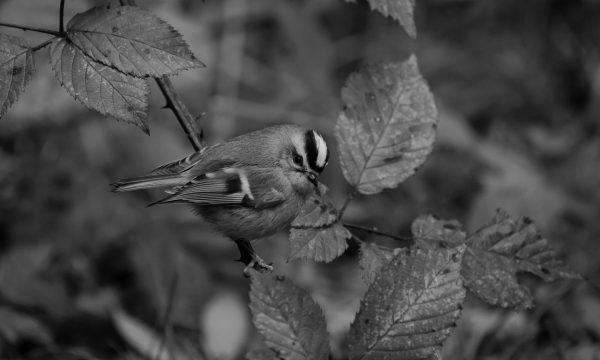Bird of the week: Golden-crowned Kinglet
About: A very small songbird with light gray-brown belly, olive greenish wing feathers, a black eyebrow stripe and flashy lemon-yellow crest. They have a very high-pitched call and song, which helps birders locate them because they like to lurk in dark, dense conifers.
Where to find this bird: Look for golden-crowned kinglets in thick, dark conifers and shrubs. They are often found high in trees and will flock with other songbirds. Listening for the call will help you locate this species.
When to find this bird: Late September to early May.
Fun fact: Kinglet pairs usually raise two broods of chicks every season, even in the short breeding season of their northern range. To do this, the female only feeds the young until the day after they leave their nest and starts laying her second clutch while the male continues to feed the young, which can be up to nine nestlings, and occasionally feeds the female as well.

Birding by ear
I have a great pair of binoculars that I always have with me while I’m out birding, but I actually do not use them that much. Most birds I identify by ear — I would guess that 80-90% of birds I identify by ear and probably about 75% I never actually see. Birds often lurk deep in the brush or high in the trees, which makes them quite hard to see, but their sounds will give them away because they vocalize a lot. Some species, such as alder and willow flycatchers, can only reliably be identified by their calls.
I have spent almost a decade learning as many bird sounds as I can, so I know most in our area, but I still often need a short refresher every spring when new birds come through and birds start singing again. For this column, I thought I would give a few tips and pitfalls to learning bird song that have helped me learn the hundreds of calls I hear every month.
To start learning calls, I have found it really helpful to see the vocalizing bird, which helps me associate the sound with the visual identification of the bird. Of course, this requires one to find the bird, but I find this is often worth some effort, particularly for calls that I do not recognize but hear frequently. Coming up with a mnemonic also really helps, whether it is one from a bird book or one you assign to a bird. Some of my favorite mnemonics are “whichity-whichity-whichity” for the song of the common yellowthroat; “drink-your-tea” for the song of the eastern towhee; and “omba-dee-da” for the song of the red-winged blackbird.
Becoming acquainted with common bird calls in your area also really helps because then uncommon bird calls are easily recognized as something rare. Having a rough idea of the kinds of sounds different bird families make and which species from different families sound similar can also help narrow down options when you hear an unfamiliar call.
This rough knowledge of approximately which bird families make which sounds is particularly handy for me when I travel, as I often do not know every bird call in an area I have never been but can narrow things down pretty quickly when I have a short list of birds that sounded a certain way. Understanding what birds have a wide range of calls and what species have dialects (something that can come with subspecies variances) is also particularly helpful, as one can be on the lookout for odd calls that sound similar to other calls but are slightly varied.
Being aware of birds that mimic other birds, such as mockingbirds, catbirds, starlings and jays, is also helpful, as these birds can pretend to be birds that they are not. Being familiar with how these birds mimic (and why) can also help rule out these tricksters in the field. Catbirds and mockingbirds tend to mimic many different species in short succession (mockingbirds being more convincing at mimicry than catbirds), while jays tend to mimic predators (like redtail hawks) in their attempt to scare other birds away from food sources.
It is important to remember that it takes years to learn bird calls, and even after almost a decade, I have many calls I am stumped by because many birds have many different calls, some of which are just really hard to differentiate or are rarely heard. Of course, birding with other birders is the best way to learn new bird calls, as they can share their knowledge, but with Merlin’s sound ID feature it is easier than ever to identify calls. Though, it’s important to remember that it is not foolproof and may not include all the calls or dialects for all species! If you are curious about accessing more calls for birds or accessing bird calls in a specific region, Xeno-Canto and the Macaulay Library have millions of bird recordings that can be filtered by region and may help identify obscure calls (if you have an idea of what it could be) or learn regional dialects in birds.
